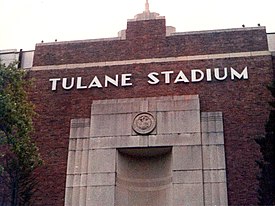Tulane Stadium
| The Sugar Bowl | |
 |
|
| Location |
New Orleans, Louisiana |
|---|---|
| Coordinates | 29°56′34″N 90°7′3″W / 29.94278°N 90.11750°WCoordinates: 29°56′34″N 90°7′3″W / 29.94278°N 90.11750°W |
| Owner | Tulane University |
| Operator | Tulane University |
| Capacity | 80,985 (1956–1975) 80,735 (1947–1955) 69,000 (1939–1946) 49,000 (1937–1938) 35,000 (1926–1936) |
| Record attendance | 86,598 (December 1, 1973) |
| Surface |
Poly-Turf (1971–1979) Grass (1926–January 1, 1971) |
| Construction | |
| Broke ground | April 7, 1924 |
| Opened | October 23, 1926 |
| Closed | August 3, 1975 |
| Demolished | November 18,1979-June 15,1980 |
| Construction cost | $295,968 ($4 million in 2017 dollars) |
| Tenants | |
|
Tulane Green Wave (NCAA) (1926–1974) Sugar Bowl (NCAA) (1935–1974) New Orleans Saints (NFL) (1967–1974) Pelican Bowl (NCAA) (1974) |
|
Tulane Stadium was an outdoor football stadium located in New Orleans, that stood from 1926 to 1980. Officially known as the Third Tulane Stadium, it replaced the "Second Tulane Stadium" where the Telephone Exchange Building is now located. The former site is currently bound by Willow Street to the south, Ben Weiner Drive to the east, the Tulane University property line west of McAlister Place, and the Hertz Basketball/Volleyball Practice Facility and the Green Wave's current home, Yulman Stadium, to the north.
The stadium hosted three of the first nine Super Bowls in 1970, 1972, and 1975.
The stadium was opened in 1926 with a seating capacity of roughly 35,000 on the sidelines of the field. Tulane Stadium was built on Tulane University's campus (before 1871, Tulane's campus was Paul Foucher's Plantation, where Foucher's father-in-law, Etienne de Bore, had first granulated sugar from cane syrup).
Since the institution of the annual Sugar Bowl game, Tulane Stadium itself was often informally referred to as "the Sugar Bowl". It was also billed as "The Queen of Southern Stadiums". It was in a portion of Tulane University's main campus in Uptown New Orleans fronting Willow Street, with parking stretching to Claiborne Avenue. The original 1926 structure was mostly of brick and concrete.
The first Sugar Bowl game was played at the stadium on January 1, 1935, matching host Tulane against the Temple Owls from Philadelphia. The term "Sugar Bowl" had been coined by Fred Digby, sports editor of the New Orleans Item, who had been pushing for an annual New Year's Day football game since 1927.
The stadium was eventually expanded to seat up to 80,985 fans. In its final configuration, the stadium included four concrete and steel sections (separated at the corners of the field), with a short steel upper deck wrapping around the sides and north end of the stadium. The press box was located on the western side of the field, and the main gate (pictured above) was at the southern end of the field facing Willow Street. The support structure for the upper deck was entirely open, exposing the ramps and lattice work, and hiding the original brick facade underneath with the exception of the Willow Street end of the stadium. Lights were installed in 1957. The record attendance for the stadium was set on December 1, 1973, when 86,598 watched Tulane defeat in-state rival LSU 14-0, ending a 25-year winless streak for the Green Wave against the Bayou Bengals. It was the last installment of the LSU-Tulane rivalry played on the Tulane campus.
...
Wikipedia
